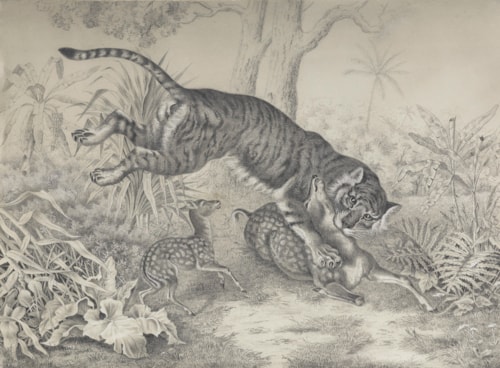
Raden Sarief Bustaman SALEH
Semarang 1811 - Bogor 1880
Biography
Born into a noble family on the island of Java, Raden Saleh is regarded as a pioneer of modern Indonesian painting. Raised by an uncle, the regent of Semarang in Java, the young Prince Raden Saleh received his initial artistic training with a Belgian painter working in Java, Antoine Payen. After winning a scholarship from the Dutch government in 1829, the young Javanese artist settled in The Hague, where he completed his studies with the portrait painter Cornelis Kruseman and the landscapist Andries Schelfhout. He lived in Holland until 1839, receiving private commissions for portraits, seascapes and animal drawings. Raden Saleh was to live and work in Europe for nearly twenty years, establishing a reputation as a portrait and animal painter and receiving commissions from patrons in Holland, Germany and France.
In 1839 he was sent by the Dutch government on a six-month study trip throughout Europe. After visiting France, Switzerland, England, Scotland and Germany, Raden Saleh eventually settled in Dresden. The four years he spent in Dresden he later recalled as the happiest of his life. Unlike his experiences in conservative Holland, where he dressed in Western clothing and was seen as a talented product of the Dutch colonial heritage, in Germany Raden Saleh was regarded as a particularly fascinating, cultured and exotic figure. Moving in refined artistic and social circles, he dressed in Javanese costume and came to enjoy his stature as a sort of Oriental ‘painter-prince’. In Dresden he met the sculptor Berthel Thorvaldsen and the Norwegian painter Johann Christian Dahl, whose influence can be seen in Raden Saleh’s landscapes. He became a close friend of Grand Duke Ernst II of Saxe-Coburg-Gotha, and spent several months at the court in Coburg in the 1840’s. He also spent a considerable amount of time in Paris, where he met and was influenced by Horace Vernet and exhibited at the Salon. Catering to the European taste for Romantic subjects, Raden Saleh developed a particular reputation for paintings of such exotic Oriental subjects as animal hunts. Indeed, he was especially renowned for his depictions of the combat between animals, and between humans and animals, and his paintings of such subjects were highly sought after by collectors.
In 1851, after more than twenty years in Europe and at the suggestion of his friend Vernet, Raden Saleh returned to Indonesia, where as the first European trained artist in the country he was soon in demand as a society portrait painter. He received numerous commissions from the Javanese aristocracy and enjoyed a successful and lucrative career as a portrait and landscape painter. He built a mansion on the banks of the Ciliwung river in Jakarta and was appointed curator of the art collection of the Dutch colonial administration there. Despite his local success, however, Raden Saleh seems to have missed the heady cultural milieu of Europe. He returned briefly to Europe between 1876 and 1878, but found that tastes had changed, and his work was less fashionable than it had been a quarter of a century earlier. He therefore returned to Indonesia, where he died in 1880. Three years later a special exhibition of nineteen paintings by Raden Saleh was held at the 1883 Colonial Exposition in Amsterdam. Several of Raden Saleh’s paintings were lost in a fire that destroyed the Dutch East Indian pavilion at the Exposition Coloniale Internationale in Paris in 1931.


